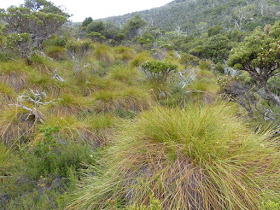I have in the (fairly distant) past, compiled alphabets of both yellow and red flowers. Today, on a mere whim, I have decided to do the same with white flowers. The 'rules', as before, are that where possible I've illustrated each letter with a genus, but where that proved unachievable I've settled for a species name. In this way I've managed to fill every letter except Z - even the hitherto unattainable Y! (Y is highly problematic because it doesn't exist in Latin.) The focus is on Australian plants, but I've included some lovely examples from both South America and Africa. It's not meant to be too deep, and I'm going away for a couple of weeks tomorrow (inter alia gathering lots of material for future posts!), so I've kept it pretty simple. Let's start - I hope you enjoy the journey!
A
B
 |
| Snow Daisies Brachyscome nivalis, Namadgi National Park, Australian Capital Territory. Another species from the south-eastern alps (and nothing in the rules says they have to be completely white!). |
C
 |
| Swamp Crinum Crinum uniflorum Family Amaryllidaceae, Kakadu National Park, Northern Territory. This lovely lily is found in damp sandy situations across northern Australia. |
D
E
F
G
H
 |
| Snakebush Hemiandra sp, Family Lamiaceae, Norseman, Western Australia. And no, I'm afraid I can't shine any light on the unlikely-sounding common name. |
I
J
K
 |
| Kunzea muelleri, Family Myrtaceae, Kosciuszko National Park, where it can be a dominant shrub in the alpine heaths. The genus commemorates German botanist Gustav Kunze. |
L
 |
| Arrayan Luma apiculata Family Myrtaceae, Alerce Andino National Park, southern Chile. This beautiful tree grows in wet forests. |
M
 |
| Carpet of Snow Macgregoria racemigera Family Celastraceae, Great Sandy Desert, Western Australia. This delightful and surprising little plant can indeed carpet the desert sands in good seasons. |
N
 |
| Giant Waterlily Nymphaea gigantea Family Nymphaeaceae, James River, Barkly Tableland, north-eastern Northern Territory. Found across northern Australia and in New Guinea. |
O
 |
| Huilmo Olysnium biflora Family Iridaceae, Torres del Paine NP, southern Chile. This is a genus of 17 iris species, all South American except for one in North America. |
P
 |
| Broad Foxtail Ptilotus nobilis Family Amaranthaceae, far northern South Australia. Found right across inland Australia, this handsome ephemeral can stretch to the horizon after good rains. |
Q
 |
| Sturt's Pigface Gunniopsis quadrifida, Family Aizoaceae, Lake Hart, South Australia. A succulent also found across the dry Australian inland, growing on the shores of dry salt lakes. |
R
 |
| Splendid Everlasting Rhodanthe chlorocephala, near Cue, inland central Western Australia. A truly magnificent daisy, found only in this region of the west. |
S
 |
| Sobralia virginalis, eastern slopes of the Peruvian Andes, east of Cusco. A striking big orchid, in this case just growing on the roadside. |
T
 |
| Tufted Grass Lily Thelionema caespitosa Family Hemerocallidaceae, Tallong, southern New South Wales. |
U
 |
| Prickly Moses Acacia ulicifolia Deua NP, southern New South Wales. A very pale-flowered wattle, common around Sydney, where its common name arose as a mangling of the original Prickly Mimosa. |
V
W
 |
| Tineo Weinmannia trichosperma Family Cunoniaceae, Salto Petrohue, southern Chile. A tree of the southern Andean wet forests, from an old Gondwanan family. |
X
 |
| Southern Cross Plant Xanthosia rotundifolium Two Peoples Bay NP, southern Western Australia. A remarkable-looking member of the carrot family - and a valid 'X'! |
Y
Which, in the sad absence of a Z plant, brings us to the end! I hope you've enjoyed this bit of trivia, and perhaps met some lovely flowers for the first time.
BACK ON THURSDAY (with one I've prepared!)
(And
remember that you can get a reminder when the next post appears by
putting your email address in the Follow by Email box in the top right
of this screen.)
I shall be away until 15 August and will not be able to reply to any comments
you make until after that, unless you do so very soon after this posting.
I shall certainly do so however, so please check back.
you make until after that, unless you do so very soon after this posting.
I shall certainly do so however, so please check back.













































